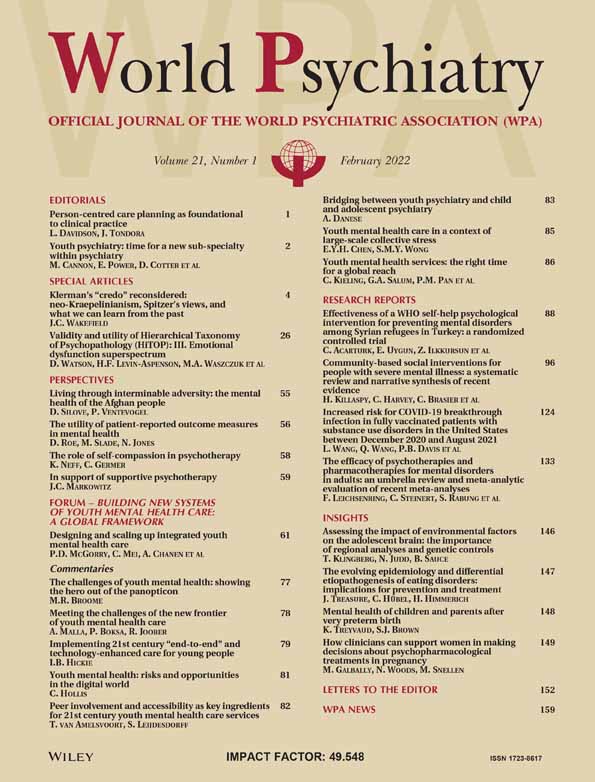身体疾病与后续精神障碍之间的关系:一项基于人群的队列纵向研究
IF 65.8
1区 医学
Q1 Medicine
引用次数: 0
摘要
据报道,患有躯体疾病的人罹患继发性精神障碍的风险较高。然而,以往的研究只考虑了几对疾病,或者只报告了相对风险。本研究旨在系统地探讨身体疾病与继发精神障碍之间的关联。研究调查了2000年至2021年期间居住在丹麦的7,673,978人,并对他们进行了总计1.193亿人年的跟踪调查。研究评估了九大类身体疾病(心血管疾病、内分泌疾病、呼吸系统疾病、胃肠道疾病、泌尿生殖系统疾病、肌肉骨骼疾病、血液和神经系统疾病以及癌症),包括 31 种具体疾病,以及随后诊断出精神障碍的风险,包括 10 个 ICD-10 分组(器质性精神障碍,包括症状性精神障碍;使用精神活性物质导致的精神障碍;精神分裂症及相关障碍;情绪障碍;神经症、压力相关障碍和躯体形式障碍;饮食障碍;人格障碍;智力障碍;广泛性发育障碍;以及通常在儿童和青少年时期发病的行为和情感障碍)。在对年龄、性别和日历时间进行调整后,采用泊松回归法计算了躯体疾病和精神障碍的总体发病率比和与时间相关的发病率比。绝对风险采用 Aalen-Johansen 估算法进行估算。在随访期间,共有 646 171 人(8.4%)被确认患有精神障碍。除癌症外,所有身体疾病都与任何精神障碍的风险升高有关。在九种躯体疾病和精神障碍的广泛配对中,IRR 的点估计中位数为 1.51(范围:0.99-1.84;四分位间范围:1.29-1.59)。癌症的 IRR 为 0.99(95% CI:0.98-1.01),肌肉骨骼疾病的 IRR 为 1.84(95% CI:1.83-1.85)。在确诊躯体疾病后,风险会随着时间的推移而变化。在确诊躯体疾病后的 15 年内,精神障碍的累积发病率从癌症的 3.73%(95% CI:3.67-3.80)到呼吸系统疾病的 10.19%(95% CI:10.13-10.25)不等。这些数据表明,大多数躯体疾病都与随后出现精神障碍的风险升高有关。治疗躯体疾病的临床医生应时刻警惕继发性精神障碍的可能发展。本文章由计算机程序翻译,如有差异,请以英文原文为准。
Associations between physical diseases and subsequent mental disorders: a longitudinal study in a population-based cohort
People with physical diseases are reported to be at elevated risk of subsequent mental disorders. However, previous studies have considered only a few pairs of conditions, or have reported only relative risks. This study aimed to systematically explore the associations between physical diseases and subsequent mental disorders. It examined a population-based cohort of 7,673,978 people living in Denmark between 2000 and 2021, and followed them for a total of 119.3 million person-years. The study assessed nine broad categories of physical diseases (cardiovascular, endocrine, respiratory, gastrointestinal, urogenital, musculoskeletal, hematological and neurological diseases, and cancers), encompassing 31 specific diseases, and the subsequent risk of mental disorder diagnoses, encompassing the ten ICD-10 groupings (organic, including symptomatic, mental disorders; mental disorders due to psychoactive substance use; schizophrenia and related disorders; mood disorders; neurotic, stress-related and somatoform disorders; eating disorders; personality disorders; intellectual disabilities; pervasive developmental disorders; and behavioral and emotional disorders with onset usually occurring in childhood and adolescence). Using Poisson regression, the overall and time-dependent incidence rate ratios (IRRs) for pairs of physical diseases and mental disorders were calculated, adjusting for age, sex and calendar time. Absolute risks were estimated with the Aalen-Johansen estimator. In total, 646,171 people (8.4%) were identified as having any mental disorder during follow-up. All physical diseases except cancers were associated with an elevated risk of any mental disorder. For the nine broad pairs of physical diseases and mental disorders, the median point estimate of IRR was 1.51 (range: 0.99-1.84; interquartile range: 1.29-1.59). The IRRs ranged from 0.99 (95% CI: 0.98-1.01) after cancers to 1.84 (95% CI: 1.83-1.85) after musculoskeletal diseases. Risks varied over time after the diagnosis of physical diseases. The cumulative mental disorder incidence within 15 years after diagnosis of a physical disease varied from 3.73% (95% CI: 3.67-3.80) for cancers to 10.19% (95% CI: 10.13-10.25) for respiratory diseases. These data document that most physical diseases are associated with an elevated risk of subsequent mental disorders. Clinicians treating physical diseases should constantly be alert to the possible development of secondary mental disorders.
求助全文
通过发布文献求助,成功后即可免费获取论文全文。
去求助
来源期刊

World Psychiatry
Nursing-Psychiatric Mental Health
CiteScore
64.10
自引率
7.40%
发文量
124
期刊介绍:
World Psychiatry is the official journal of the World Psychiatric Association. It aims to disseminate information on significant clinical, service, and research developments in the mental health field.
World Psychiatry is published three times per year and is sent free of charge to psychiatrists.The recipient psychiatrists' names and addresses are provided by WPA member societies and sections.The language used in the journal is designed to be understandable by the majority of mental health professionals worldwide.
 求助内容:
求助内容: 应助结果提醒方式:
应助结果提醒方式:


